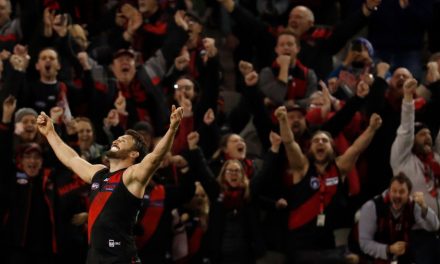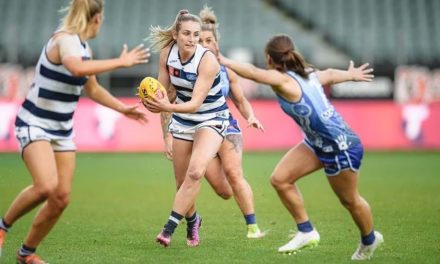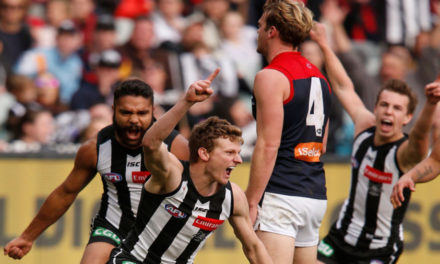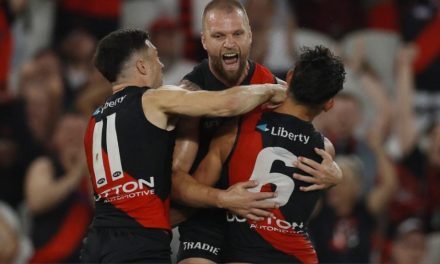The fixture for the 2021 AFL season may not even be released until February, and even then not the entire 23 rounds.
So the fridge exterior is painted brilliant white.
It has become obvious today because there is no AFL fixture (among other sporting calendars) on the big noisy box at the back of the kitchen.
Usually by Christmas that fridge is plastered with an AFL season planner – and the club magnetised program (in this case Port Adelaide; total disclosure). There also is the SANFL fixture. And there is the rundown from Major League Baseball – all 162 games assigned to the Boston Red Sox (when the professional baseball season could be a daily show from April to late October).
The English Premier League calendar has the West Ham United matches marked with the highlighter pen. And the same applies with Fiorentina in the Italian Serie A games (while those of Juventus are ruled out with the same vigour a war-time censor would put into letters from the Front).
Those totally useful magnets with the emergency numbers for police, fire and ambulance and the local plumber and electrician are relegated to the dishwasher – that also is painted white. Matching set. Who would have thought?
It is almost Christmas and the fridge is bare. Santa will be confused when he helps himself to a cold Peroni on Christmas night.
AFL executive Travis Auld might not have the fixture – and then only a partial program, say the first month or the first six rounds – ready for public release (and pinning on the fridge) until early in the New Year, or perhaps even February.
This is understandable considering the uncertainties created by the COVID pandemic. Why go through the demanding exercise of satisfying clubs, stadium contracts, broadcasters and (hopefully) fans if – as the 2020 fixture that just fell off the fridge proves – the whole program is forced into another rolling fixture by lockdowns, border closures, hubs and postponements (ala Essendon v Melbourne this year when Irish Bomber Connor McKenna did or did not test positive to COVID).
So the fridge is without its road map through AFL season 2021.
What we do know is this. The start date for the home-and-away series is 18 March, with the so-called traditional Richmond-Carlton season-opener at the MCG. There will be 22 rounds, after the truncated 17 this year. And the “footy frenzy” or “festival of football” – the continuous run of games on short turnovers across 21 or so days – remains on the planning table (if only to appease telecaster Channel 7 and to cope with the double-billing of AFL and the Tokyo Olympics in July-August).
“The later we can release the fixture,” says AFL chief executive Gillon McLachlan, “the more certainty we can give our clubs and players and supporters.”
And less headaches for Auld and his team, who must have had the most chaotic whiteboard in Australian football this year. They might – more so if there is a COVID vaccine roll-out next year – get the fixture they release to unfold as planned.
In the meantime, that annual habit of the fixture being released, followed by airlines having their booking sites swamped by football fans looking at short holidays built around an AFL game; engaged couples picking a wedding date free of a football event, and real estate agents cursing their auctions going head-to-head with Saturday blockbusters has been put on hold.
Surprisingly, though, there has not been much debate on just what the AFL fixture should be in 2021 and beyond.
The “footy frenzy” concept deserves a serious review. Seven and Foxtel will argue the condensing of matches on quick turnarounds is a winner based on this year’s television ratings – from a “unprecedented” season in which many fans were in lockdown or forced to test their luck in ballots for tickets to matches.
Next season, the footy gods willing, those fans will be back to the routine of jobs, training at community football level on Tuesdays and Thursdays and other social events.
The audience base at home – and at Docklands for a Western Bulldogs v Melbourne clash on a Tuesday night – will not be as large as it was during lockdown periods this year.
And while the AFL owes Seven heavily for its cash this year, the league cannot ignore the “stakeholders” who suffered the most and gave up the most (including money with membership dues) this year – the fans.
In interviewing AFL Fans Association president Gerry Eeman for Adelaide digital newspaper INDAILY in August, this quote resonated: “We can’t start 2021 with the feeling the fans are to be taken for granted again.
“The onus is on the clubs … they cannot treat their members as consumers. Selling a membership should not be a business transaction,” added Eeman.
“We all used to look forward to the end of the week when we could get away from our everyday problems by escaping to the footy. The game is a social glue. There are friendships made at the footy that become extensions of our family. There are family traditions that are built around going to the footy together.”
Getting the fans back to the venues – rather than keeping them in front of television sets for rating figures – needs to be a paramount consideration in Auld’s fixture planning … even if COVID puts such a fan-friendly program at risk to protocol limits on capacity at venues around the nation.
This philosophy for season 2021 should not be up for debate. But commercial deals put the AFL again into the bind of compromise. A league with the mantra of delivering a competition built on “equality and fairness” repeatedly contradicts its mission statement with the home-and-away calendar.
And this opens the door to look at the fixture concept.
CURRENTLY
22 rounds
Established in 1970 for a VFL competition of 12 Victorian-based teams – every club played its 11 rivals twice; once at home, once away. Parity was assured. And with most rounds based on six games starting at 2pm on Saturday, there was no argument about five or six-day breaks.
This 22-round model delivered a commercial basis – of 11 home games to offer in a membership package – that remains the cornerstone of AFL budgets today.
But now there are 18 national league teams. There is disparity of travel, breaks between games, access to blockbuster timeslots, the make-up of the extra five matches after playing each of the 17 rivals once and timeslots that have spread from Thursday night to Sunday twilight.
PLEASE HELP US CONTINUE TO THRIVE BY BECOMING AN OFFICIAL FOOTYOLOGY PATRON. JUST CLICK THIS LINK.
It is far from perfect – and this is emphasised by the release of the fixture being met with reviews on the “toughest” and “softest” fixture as each club’s calendar is reviewed.
The “double-up” games – the extra five matches played to take the home-and-away season to 22 rounds – do have the capacity to unfairly shape the final eight.
Changing the current 22-round model has been on the agenda since late 2016, but Auld admits “it’s incredibly complicated … there’s a lot of impacts of changing our fixture.”
Season 2020 proved the AFL can adjust very quickly – and, in the post-COVID game, there could be fixture themes that become too difficult to dismiss with the usual “can’t do that” response.
“Finding a way” in 2020 proves the AFL fixture can tolerate change – even a grand final away from the MCG. But is the league creative in solving its fixture challenges?
ALTERNATIVES
17 PLUS 5
AFL chief executive Gillon McLachlan became an advocate of this proposal in 2016. With “17 plus five” every club would play its 17 rivals once and then the competition would then be split into three six-team groups for round-robin play to decide the seedings to the top-eight finals.
This concept does get the “can’t do that” backlash. The drawbacks of “17 plus five” concept are:
NO guarantee of double-up blockbusters such as the derbies in Adelaide (the Port Adelaide-Crows Showdown), in Perth (the West Coast-Fremantle Western Derby) and in Melbourne (particularly the taken-for-granted demand for two Collingwood-Carlton matches each season). This has significant negative ramifications on the sponsorship and membership sales at clubs if they are denied “must-see” matches that are built around rivalries rather than positions on the ladder and form.
FINDING a purpose for the teams in the third group, the teams ranked 13-18. Offering draft bonuses seems yet another contradiction to the core purpose of the AFL national draft.
FINALS seedings. Would you prefer to be ranked sixth at the end of the first 17 weeks and handed a round-robin fixture against the top-five teams … or placed seventh playing teams ranked seventh-12th? Do you keep your premiership points from the first 17 rounds or start the round-robin series at zero?
JUST 17
It worked this year … but removing 45 home-and-away matches from the fixture would be costly commercially on television rights, membership packages, sponsorship and to venue operators.
There are some major contracts – particularly at venues such as the MCG – that just cannot be renegotiated, more so after a COVID hit.
And it makes for a quick season … unless the case is made for State-of-Origin to fill the gap.
UP TO 27
Brownlow medallist Patrick Dangerfield – the AFL Players’ Association president – is keen. But with provisos – more games but shorter matches with quarters of less than 20 minutes (ala the 16 of this season) to ease the demands on the players.
“I definitely think the conversation should be had around playing more than 22 games a season and especially when you have the ability to pivot and be fluid about how the fixture is run,” Dangerfield said earlier this year. “You might lock in a fixture for the first eight weeks and then having a floating fixture for (the next period of the matches).
“I think we’ve all got to be open to all potential changes and if that’s an increase in games … it might be (as many as) 27 games in a season with a slightly shorter game length, I think that’s something we should consider.”
DOUBLE UP 34
Just as the VFL worked out in 1970, the AFL would need 34 rounds for a truly equitable home-and-away fixture that has all 18 teams play all their rivals once at home and once away.
This makes for a long season – unless there are “footy frenzy” sessions to cram the calendar.
Many venues would not be available to the AFL if the home-and-away season had to be extended by 12 weeks.
And who would endure the 34-week marathon if – as Adelaide did this year – a team starts with a 0-13 win-loss record?
CONFERENCES
Immediately someone will yell, “not another American system for our footy” after the AFL has adopted the US professional sporting themes of the draft and salary cap.
But conferences are actually an Australian football invention. The early VFL competition developed group or conference systems to decide finalists.
The AFL could split its league into three six-team groups to deliver perfect parity for each club in every conference. There would be 22 rounds – 10 rounds with home-and-away repeated twice for the six teams in a conference; 12 rounds with one-off games against the 12 teams in the other two conferences.
Every team has the same draw as its conference rivals. Total fairness. Travel demands within the groups would offer parity not known today with the 22-round fixture.
The questions to be answered are: How to split the 18 teams? Separating Adelaide and Port Adelaide or West Coast and Fremantle would end the routine of two derbies each season in South Australia and Western Australia. Will there be “strong” and “weak” conferences? How are the eight finalists decided – top two in each conference and the two best third-placed teams? Or a combined 18-team ladder? Wildcards?
The more that is asked about the alternatives, the current 22-round home-and-away fixture appears preferable even with all its annual talking points on travel (or lack of it for teams such as Collingwood), long sequences of games at the MCG for Richmond, Friday night exposure (or the lack of it for some clubs), five-day breaks, coverage on national free-to-air television.
It might be time to grab some cold beers from that now naked fridge to debate all this while Auld works out when it might be safe to release the AFL 2021 fixture.













Call it lock down boredom – and apologies for being late to the party – but a slightly different take on how a 17+5 model could work would be to split the season into 3 phases.
Phase 1: Home & Away
– Everyone plays each other once from rounds 1 to 17
– At the end of the 17 rounds, teams are then put into 3 groups to play 5 remaining rounds:
– 1) The top 6,
– 2) ‘Odds’: 7,9,11,13,15,17
– 3) ‘Evens’: 8, 10, 12 ,14 16,18
– McClelland trophy awarded to top team of Phase 1 (And properly awarded on field to top team in opening game of Phase 2)
Phase 2: Post Season / Qualifying
– The six teams from each group play each other once. Points and percentage are reset and no draws (extra time)
– The Minor Premier/ McClelland trophy winner (from Phase 1) receives a bonus point/s as reward for finishing 1st
– The top 3 teams in each group have 3 home games (2 away), while the bottom three teams have 2 home games (3 away) – perhaps
determined by a televised lottery following final game of Phase 1.
– The Top 6 are guaranteed to play finals – and are playing for the double chance (top 4)
– The team that finishes first in ‘Odds’ would then play second of ‘Evens’ – and vice versa – in a wildcard weekend. The winners of these two
games would then make up the top 8
Phase 3: Finals
– Top 8 format as currently is
The main benefit of this is that it gives the teams in the bottom something to play for. The draft could then be lotteries of 6 teams based on final positions etc. As per the article, push back most likely comes from no guarantee of rivalry rounds, and probably makes selling memberships harder. If season 2021 has proven anything though; clubs and fans are adapting to a changing footy landscape.
Cheers.
why don’t you increase the afl to 20 teams and then have a division 1 and 2 with promotion and relegation that way each team in each division would at least play teams in their division twice